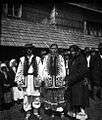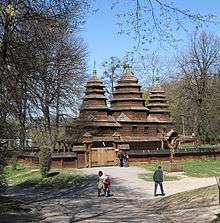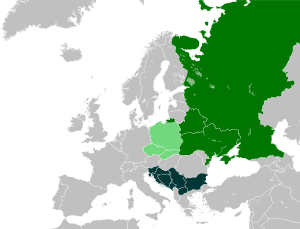Boykos
Boykos (Ukrainian: Бойки, romanized: Boyky; Polish: Bojkowie; Slovak: Pujďáci), or simply Highlanders (верховинці, verkhovyntsi), are a Ukrainian ethnographic group located in the Carpathian Mountains of Ukraine, Slovakia, Hungary, and Poland. Along with the neighboring Lemkos and Hutsuls, the Boykos are a sub-group of the Rusyns, who are often regarded as a sub-group Ukrainian people and speak a Rusyn language, which is often considered as a dialect of the Ukrainian language.[3][4] Boykos differ from their neighbors in dialect, dress, folk architecture, and customs.
 Boyko family of Maniava, late 19th century | |
| Regions with significant populations | |
|---|---|
| 131 (2001)[1] | |
| 258 (2011)[2] | |
| Languages | |
| Ukrainian | |
| Religion | |
| Greek Catholicism, Orthodox Christianity | |
| Related ethnic groups | |
| Ukrainians · Rusyns · Lemkos · Hutsuls | |
| Part of a series on |
| Ukrainians |
|---|
 |
| Diaspora |
|
see Template:Ukrainian diaspora |
| Sub-national groups |
| Boikos · Hutsuls · Lemkos · Poleszuks |
| Closely-related peoples |
|
East Slavs (parent group) Rusyns · Poleszuks · Kuban Cossacks Pannonian Rusyns |
| Culture |
|
Architecture · Art · Cinema · Cuisine Dance · Language · Literature · Music Sport · Theater |
| Religion |
|
Eastern Orthodox (Moscow Patriarchate Orthodox Church of Ukraine) Greek Catholicism Roman Catholicism Judaism (among ethnic Jews) |
| Languages and dialects |
|
Ukrainian Russian · Canadian Ukrainian · Rusyn · Pannonian Rusyn Balachka · Surzhyk · Lemko |
|
History · Rulers List of Ukrainians |
Etymology
For the origin of the name Boyko exist several etymological hypotheses,[5] but it is generally considered, as explained priest Joseph Levytsky in his Hramatyka (1831), that derives from particle boiie.[6] Specifically, it derives from the exclamation "бой!, бойє!" (< bo-i-je), meaning "it is really so!", which is often used by the population.[7] The 19th-century scholar Pavel Jozef Šafárik, with whom agreed Franjo Rački and Henry Hoyle Howorth, argued direct connection of the Boykos with the region of Boiki mentioned in the 10th century De Administrando Imperio,[6][8] but this thesis is outdated and rejected,[7] as most scholars like Mykhailo Hrushevsky already dismissed it in the 19th century because Boiki is a clear reference to Bohemia, which in turn derives from Celtic tribe of Boii.[9][10] The derivation from Boii,[5] is also disputed because there is not enough evidence.[6] Like in the case of Hutsuls and Lemkos, they are recorded in historical and ethnographic sources since the 18th and 19th century.[11]
Origin
Like other Rusyn subgroups, they are considered as one of the descendants of East Slavic tribes, specifically White Croats who lived in the region,[5][6][12] possibly also Ulichs who arrived from the East,[13] and partly Vlach shepherds who later immigrated from Transylvania.[12]
Demography
In the region inhabited by Boykos, named as Boikivshchyna, lived up to 400,000 people of whom mostly were Boykos.[6][14] They also lived in Sanok, Leskom and Przemyśl County of the Podkarpackie Voivodeship in Poland, before the forced relocation in 1947.[15] In memory of Boykos, Ukraine's national parliament, the Verkhovna Rada, in 2016 renamed Telmanove Raion into Boykivske Raion where Boykos were deported from Czarna, Bieszczady County (today in Poland) after the 1951 Polish–Soviet territorial exchange. In 1970, was evaluated that lived 230,000 people of Boyko's origin.[15]
In Ukraine, the classification of Boykos and other Rusyns as an East Slavic ethnicity, distinct from Ukrainians is controversial.[16][17][18] The deprecated and archaic term Ruthenian, while it is also derived from Rus', is ambiguous, as it technically may refer to Rusyns and Ukrainians, as well as Belarusians and even Russians, depending on the historical period. According to the 2001 Ukraine census, only 131 people identified themselves as Boykos, separate from Ukrainians.[1] However, this figure is distorted because some people otherwise identifiable as Boykos regard that name as derogatory.[6] In the Polish census of 2011, 258 people identified their nationality as Boyko, with 14 people listing it as their only national identification.[2]
Location
- Poland: southeasternmost part of Poland (Podkarpackie Voivodeship).
- Ukraine: central and western half of the Carpathians in Ukraine across such regions as the southern Lviv Oblast (Skole, Turka, Drohobych, Sambir and Stary Sambir Raions), western Ivano-Frankivsk Oblast (Dolyna and Rozhniativ Raions) and parts of the northeastern Zakarpattia Oblast (Mizhhiria Raion)
- Northeast Slovakia
To the west of Boykos live Lemkos, east or southeast Hutsuls, and to the south or southwest other Carpathian Rusyns.
 Ethnographic groups of southeasternmost Poland, Boykos in dark blue.
Ethnographic groups of southeasternmost Poland, Boykos in dark blue. Highlander groups of westernmost Ukraine, Boykos in brown.
Highlander groups of westernmost Ukraine, Boykos in brown. Boyko inhabitants of Galicia, lithograph from 1837
Boyko inhabitants of Galicia, lithograph from 1837 Boyko man, 1925–1939.
Boyko man, 1925–1939. Boyko family, prewar.
Boyko family, prewar..jpg) Boyko family, prewar.
Boyko family, prewar.
Religion
Most Boykos belong to the Ukrainian Greek Catholic Church, with a minority belonging to the Ukrainian Orthodox Church. The distinctive wooden church architecture of the Boyko region is a three-domed church, with the domes arranged in one line, and the middle dome slightly larger than the others.
Notable people
- Yuriy Drohobych (1450–1494), first doctor of medicine in Ukraine, rector of the University of Bologna (1481–1482), professor at Jagiellonian University (1488).[5]
- Petro Konashevych-Sahaidachny (1582–1622), Ukrainian political and civic leader, Hetman of Ukrainian Zaporozhian Cossacks (1616–1622).[5]
- Ivan Franko (1856–1916), Ukrainian poet, writer and political activist.[5]
See also
References
- Ukrainian Census 2001
- Ludność. Stan i struktura demograficzno-społeczna. Narodowy Spis Ludności i Mieszkań 2011 (National Census of Population and Housing 2011). GUS. 2013. p. 264.
- [Richard T.Schaefer (ed.), 2008, Encyclopedia of Race, Ethnicity, and Society, Volume 1, SAGE Publications, p. 1341.
- James Stuart Olson, Lee Brigance Pappas & Nicholas Charles Pappas, 1994, An Ethnohistorical Dictionary of the Russian and Soviet Empires, Greenwood Publishing Group, pp. 109–110.
- Войналович В.А. (2003). БОЙКИ. Encyclopedia of Ukrainian History (in Ukrainian). 1. Naukova Dumka, NASU Institute of History of Ukraine. p. 688. ISBN 966-00-0734-5.
Стосовно походження та етимології назви "Б." існує кілька гіпотез. Одні пов'язують її з особливостями психічного складу певної групи людей, ін. – з особливостями їхніх мовнодіалектичних ознак (бойківський говір – одна з пд.-зх. карпатських говірок – зберіг чимало архаїчних рис, переважно фонетичних та морфологічних). Достатньо обґрунтованою є гіпотеза, що пов'язує цю назву з етнонімом кельтських племен – "бойї", які мігрували у 6 ст. на Балкани і в Карпати. Подекуди Б. називають себе верховинцями. На Закарпатті назва "Б." мало поширена ... Гадають, що Б. – нащадки давнього слов'ян. племені білих хорватів, яких Володимир Святославич приєднав до Київської Русі
- Sofiia Rabii-Karpynska (2013) [1984]. Boikos. Internet Encyclopedia of Ukraine. 1. University of Toronto Press. ISBN 978-0802033628.
The name boiko is thought to be derived from the frequent use of the particle boiie by the population. The Boikos are believed to be the descendants of the ancient Slavic tribe of White Croatians that came under the rule of the Kyivan Rus’ state during the reign of Prince Volodymyr the Great. Before the Magyars occupied the Danube Lowland this tribe served as a direct link between the Eastern and Southern Slavs. Some of the early Slav specialists, such as Pavel Šafařík and F. Rački, interpreted the remark of the Byzantine king Constantine VII Porphyrogenitus (10th century) that the ‘Boiky’ locality situated beyond Turkia (ie, Hungary) was the homeland of the White Serbs as a reference to the present Boiko region. This hypothesis is possibly true, but unproved. Likewise, no evidence exists to establish a connection between the name of the Boikos and the Celtic tribe of Boii, according to Yaroslav Pasternak.
- Jaroslav Rudnyckyj (1962–1972). An Etymological Dictionary of the Ukrainian Language: Parts 1–11, A–G (in English and Ukrainian). 1. Winnipeg: Ukrainian Free Academy of Sciences (UVAN). p. 162.
- Howorth, H. H. (1878). "The Spread of the Slaves. Part I. The Croats". The Journal of the Anthropological Institute of Great Britain and Ireland. 7: 326. doi:10.2307/2841009. JSTOR 2841009.
- Mykhailo Hrushevsky (1997) [1898]. Andrzej Poppe; Frank E. Sysyn; Uliana M. Pasiczny (eds.). History of Ukraine-Rus'. Volume 1: From Prehistory to the Eleventh Century. Translated by Marta Skorupsky. Canadian Institute of Ukrainian Studies Press. pp. 161–162. ISBN 978-1-895571-19-6.
The second detail in Constantine's account, which supposedly points to the eastern Carpathians, is his reference to a 'place called Boiki (Boiki)' on the border with the White Serbs; for a long time this was considered — and some consider it still – to be a reference to the Ukrainian Boikos. That is very unlikely, however, because the location is too far east for the Serbs, nor is there any indication that the name of the Boikos was ever in such wide usage. So all we are left with to suggest the existence of a Rus' Croatia in the Carpathians is the Primary Chronicle ... Published by H. Jireiek, the Karten zur Geschichte (1897) also show the 'Boiki' on the Dnister (map 4). It is more likely that Boiki is a distorted variant of the name Boiohem, or Bohemia, as most scholars now believe...
- Gyula Moravcsik, ed. (1949). De administrando imperio. Pázmány Péter Tudományegyetemi Görög Filoĺ́ogiai Intézet. pp. 130–131.
...should be modern Saxony, where remnants of Serbs (Sorbs) are still living. The name 'Boiki' has been much disputed over by specialists ... has proved that the 'place called Boiki' can only be Bohemia. Grégoire (L'Origine, 98) rejects Skok's proposal to read 'Boioi', and suggests 'Boimi'. C.'s account contains one serious inexactitude: namely, the statement that the Serbs lived 'in a place called by them Boiki'. Although we have documentary proof of the existence of Croats in Bohemia, we have none to suggest that Serbs lived there. Bohemia was in fact another neighbour of White Serbia
- Вортман Д.Я., Косміна О.Ю. (2007). КАРПАТИ КРАЇНСЬКІ. Encyclopedia of Ukrainian History (in Ukrainian). 4. Naukova Dumka, NASU Institute of History of Ukraine. ISBN 978-966-00-0692-8.
Історико-етнографічні джерела кін. 18 – поч. 19 ст. фіксують наявність у К.У. субетнічних груп українців: бойків, лемків, гуцулів.
- Magocsi, Paul Robert (1995). "The Carpatho-Rusyns". Carpatho-Rusyn American. XVIII (4).
The purpose of this somewhat extended discussion of early history is to emphasize the complex origins of the Carpatho-Rusyns. They were not, as is often asserted, exclusively associated with Kievan Rus', from which it is said their name Rusyn derives. Rather, the ancestors of the present-day Carpatho-Rusyns are descendants of: (1) early Slavic peoples who came to the Danubian Basin with the Huns; (2) the White Croats; (3) the Rusyns of Galicia and Podolia; and (4) the Vlachs of Transylvania.
- George Shevelov (2002) [1979]. "A Historical Phonology of the Ukrainian Language" (in Ukrainian). Retrieved 2008-07-23.
Говорячи про Україну, слід брати до уваги такі доісторичні слов’янські племена, перелічені та/або згадані в Київському Початковому літописі, як деревляни (Середнє Полісся), сіверяни (Східне Полісся), поляни (Київщина, цебто ядро Русі), бужани (називані також волинянами або дулібами), уличі або улучі, тиверці (Подністров’я) та хорвати (Карпати? Перемищина?). Дуліби востаннє згадуються в записі за 907 р., уличі за 922 р., поляни й тиверці за 944 р., деревляни за 990 р., хорвати за 992 р., сіверяни за 1024 р. Дивлячись суто географічно, середньополіські говірки можуть бути виведені від деревлян, східнополіські від сіверян, західноволинські від дулібів; висловлено також гіпотезу, обстоювану — з індивідуальними нюансами — низкою вчених (Шахматовим, Лєр-Сплавінським, Зілинським, Нідерле, Кобилянським та ін.), що гуцули, а можливо й бойки, є нащадками уличів, які під тиском печенігів залишили свої рідні землі над Богом, переселившися до цієї частини карпатського реґіону. Проте нам нічого не відомо про мовні особливості, якими відрізнялися між собою доісторичні слов’янські племена на Україні, а отже будь-які спроби пов’язати сучасні говірки зі згаданими племенами ані довести, ані, навпаки, спростувати незмога.
- Ісаєвич Я.Д. (2003). БОЙКІВЩИНА. Encyclopedia of Ukrainian History (in Ukrainian). 1. Naukova Dumka, NASU Institute of History of Ukraine. p. 688. ISBN 966-00-0734-5.
- И. А. Бойко (2016). БО́ЙКИ. Great Russian Encyclopedia (in Russian). Bolshaya Rossiyskaya Entsiklopediya, Russian Academy of Sciences.
До насильственного переселения 1947 жили также в Саноцком, Леском и Перемышльском поветах Подкарпатского воеводства в Польше. В 1970 насчитывалось ок. 230 тыс. чел. (оценка).
- Professor Ivan Pop: Encyclopedia of Subcarpathian Ruthenia(Encyclopedija Podkarpatskoj Rusi). Uzhhorod, 2000..
- Paul Robert Magocsi, Encyclopedia of Rusyn History and Culture . University of Toronto Press, June 2002.
- Tom Trier (1998), Inter-Ethnic Relations in Transcarpathian Ukraine
External links
| Wikimedia Commons has media related to Boykos. |
- Anatoliy Ponomariov. "Ethnic groups of Ukrainians" (in Ukrainian). Available online.
- Nakonechny, Ye. "How Ruthenians became Ukrainians", Zerkalo Nedeli (the Mirror Weekly), July, 2005. Available online in Russian and in Ukrainian.
- Short photo essay about contemporary Boiko life.
- Romaniuk, K. Characteristics of Boikos dialect use in Kherson region in the mid 20th century. "Domiv". 8 March 2016.

